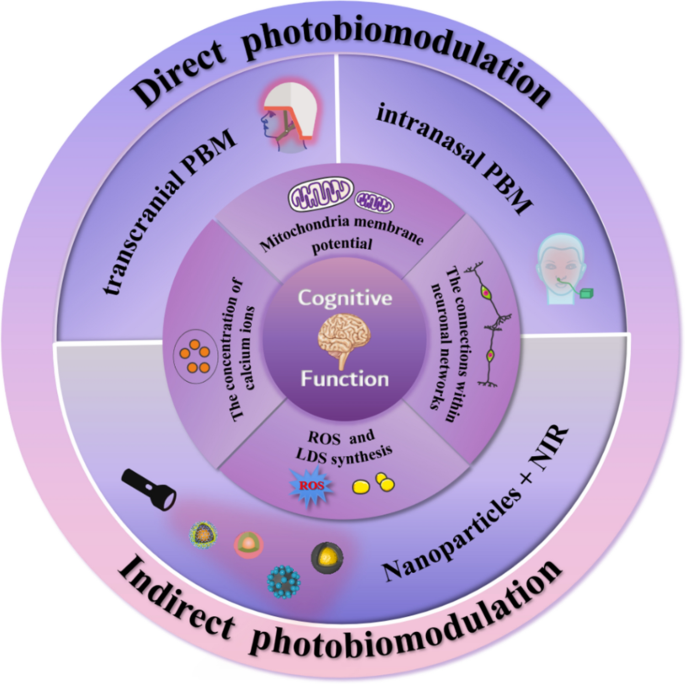Not known Facts About Photobiomodulation
Wiki Article
Indicators on Photobiomodulation You Need To Know
Table of ContentsPhotobiomodulation - An OverviewThe Main Principles Of Photobiomodulation Rumored Buzz on PhotobiomodulationSome Known Details About Photobiomodulation
Laser treatment is a medical treatment that uses concentrated light to promote a procedure called. Throughout PBM, photons go into the tissue and interact with the cytochrome c facility within mitochondria. This interaction triggers an organic cascade of occasions that results in a boost in mobile metabolism, which can along with speed up the healing procedure.There is consensus that the application of a therapeutic dose of light to damaged or inefficient tissue brings about a cellular response moderated by mitochondrial systems. Photobiomodulation. Studies have actually shown that these modifications can impact discomfort and inflammation, along with, tissue fixing
Modifications in ATP, responsive oxygen varieties and nitric oxide adhere to light absorption by Cc, O. These results are redox state and dosage dependent. In hypoxic or otherwise worried cells it has been shown sometimes that complying with, nitric oxide is released, ATP is boosted and oxidative tension is decreased [27-31]

Photobiomodulation Things To Know Before You Get This
PBM gadgets have been cleared for advertising and marketing by FDA with the Premarket Notification/510( k) process as adjunctive gadgets for the momentary relief of pain. These clearances were based on the presentation of professional information to support such claims (Photobiomodulation). In this treatment, a light is positioned near or in call with the skin, allowing the light power (photons) to penetrate cells where it communicates with chromophores located in cells causing photophysical and photochemical adjustments that bring about changes at the molecular, cellular and cells levels of the bodyInterestingly, recent study suggests that light can enhance efficiency in typical cells and cells. The possible applications of PBMT are various and are being explored experimentally at the fundamental scientific research, pre-clinical and scientific degree. The existing clinical usages are for the alleviation of pain and inflammation and the treatment of sports injuries.

The treatment specifications and number of sessions required for PBMT are reliant upon place and reason. PBMT usually calls for more than one treatment for ideal discomfort relief.
How Photobiomodulation can Save You Time, Stress, and Money.
Therapy specifications for PBMT were initially established using cells in vitro and in small pet models. These therapy specifications usually had a low irradiance and fluence and functioned well for cutaneous applications. When medical professionals began to make use of PBMT to treat frameworks that were situated deeper in the body, they made use of these parameters with adverse outcomes.
We now comprehend that these negative researches was because of wrong device and treatment parameters for transcutaneous treatment of much deeper frameworks. Current advances in laser therapy gadgets and more study right into the appropriate does have actually dramatically boosted the outcomes of PBMT. For dealing with deep tissues, the wavelength of light utilized determines the depth of penetration into a cells.
For that reason, it is necessary that a medical professional uses the proper wavelength of light and specifications to deal with a condition. One wavelength and one collection of therapy criteria will certainly not work for all conditions. Unfavorable side impacts have actually not been reported from using PBMT (Photobiomodulation). Upgraded June 27, 2016Juanita her response j
Light therapy is a non-invasive therapy that works by enhancing the ability of the cell to produce energy (ATP) to heal the location being dealt with. Therefore, it can lower swelling, swelling, and pain in the area. Research study in this location is increasing, with even more comprehensive study documents linked listed below for Homepage those who want to discover more.
Some Known Facts About Photobiomodulation.
In the first experiment, Dr. Endre Mester, made use of shaved rats and observing just how the laser affected their capability to grow hair contrasted to the group that was not getting LLLT. He found that the group of computer mice obtaining LLLT were able to expand their hair back quicker than the group of computer mice that really did not get LLLT (Hoon C, et alia; 2012).This therapy is called this means to separate the distinction between the lasers some occupations utilize to reduce (eg. in surgical treatments, or oral procedures). Low-level light treatment is pain-free, non-invasive therapy. It is utilized to reduce inflammation, swelling, and chronic joint problems, decrease pain and accelerate injury recovery of nerves and tissues (Hoon C, et alia; 2012).
LLLT has a biphasic reaction, indicating that reduced doses are generally seen to be extra useful than higher doses. That being said, doses greater or reduced than the optimal dosage doesn't affect (Hoon C, et al; 2012). straight from the source For this reason, it can be difficult to have researches on LLLT with so numerous criteria.
Some firms integrated both (LED and laser) to provide a much more well-rounded treatment given that lasers can permeate deeper than LED and infrared light (Norman Doidge, The Mind's Means of Recovery, 2015). During treatment, the location that is being dealt with is subjected to LED light from a Biography, Flex Laser, which is at 660 nm wavelength, complied with by infrared light at 830-840 nm wavelength.
Report this wiki page